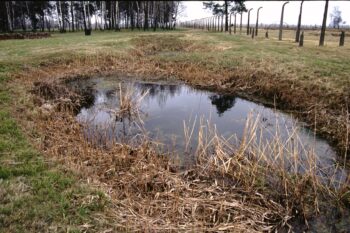Groundwater Level
Many alleged Holocaust crime sites are said to have included pits of various depths. These would have been dug for one of two reasons: either to bury (temporarily or permanently) victims’ bodies, or to use as “burn pits” to dispose of the corpses. In the second case, the burnings allegedly occurred either immediately after their murder, or much later, after their corpses had been first buried but then exhumed again in order to erase evidence of these crimes. The latter is true for almost all claimed crime sites connected with the Einsatzgruppen shootings and the so-called Aktion 1005, and with most victims purportedly killed in the camps of the Aktion Reinhardt: Belzec, Sobibór and Treblinka, plus Chełmno.
A special case is Auschwitz Camp, where some 100,000 victims of diseases and mass murder are said to have been first buried, but then, starting in September of 1942, exhumed again and burned on pyres in deep pits. These pits are said to have been used until March/April 1943, when the Birkenau crematoria started coming into operation. Furthermore, during the deportation of Jews from Hungary to Auschwitz between mid-May and early July 1944, new pits are said to have been dug and used to cremate many, if not most, of the claimed murdered Jews.
Air photos of Birkenau show no signs of large pits during the spring and summer of 1944 – as would have been required for the claimed open-air incineration. But the claims made about deep pits run into further problems, because the Auschwitz-Birkenau Camp was located in the vicinity of the confluence of three rivers: the Sola, the Vistula and the Przemsza River. Therefore, depending on the water level of these rivers, the groundwater level in the area of the Birkenau Camp could be as high as just a few inches below the surface, or even right up to the surface – turning the entire area into a swamp.

Under these circumstances, it was physically impossible to dig pits deeper than about one meter (three feet) without groundwater swiftly filling them in. For this reason, the construction pits for the three buildings at Birkenau which had a basement – Crematoria II and III as well as the so-called Zentralsauna – had to have intruding groundwater continuously pumped out. Many documents about the hours spent for this work have been preserved.
Equally preserved are several documents addressing the high groundwater level and the problems resulting from it for the area’s various camps and for the entire area, primarily worries about contaminating the drinking water.
During the construction of Birkenau, drainage ditches were dug to lower the groundwater level inside the growing camp. However, the large pits said to have been operated near the so-called “bunkers” were located outside the camp perimeter, hence would not have been included in this system of drainage ditches. The depth of the cremation pits claimed for that area is said to have been between two and four meters, depending on the witness (see the table). At that depth, these pits would have filled up with groundwater quickly, foiling any attempt at initiating or maintaining open-air incinerations in them.
|
Witness |
Depth |
Location |
|---|---|---|
|
1.5 m |
near Crematorium V |
|
|
4 m |
near “Bunker 2” |
|
| Leon Cohen |
3 m |
near “Bunker 2” |
|
3 m |
near Crematorium V |
|
|
2 m |
near Crematorium V |
|
| Kurt Marcus |
4 m |
near “Bunker 2” |
|
2 m |
near Crematorium V |
|
|
3 m |
near “Bunker 2” |
|
|
2 m |
unspecified |
|
|
Source: Mattogno 2016b, p. 28; for more details, see the entry on open-air incinerations. |
||
For similar reasons, mass graves dug in the vicinity of the Birkenau Camp could not have been much deeper than a meter – not only because they would, again, have filled quickly with water, but more importantly, submersing corpses in groundwater contaminates it. Bacteria and viruses diffuse from corpses soaked in water, and would very adversely affect the health of all those drinking water in the region.
Air photos show that mass graves existed indeed, but probably only very shallow graves, and only for a very limited time (see the entry on air photos). Due to the danger of contaminating the drinking water, these bodies were probably exhumed again starting in late summer of 1942, and incinerated on pyres. The atrocious scenes that must have accompanied this activity probably formed the true core of the rumors about mass murder at Auschwitz. (For details on the groundwater level at Auschwitz and its relevance to Holocaust claims, see Gärtner/Rademacher 2003, Mattogno 2003a; Mattogno 2016b, pp. 97-127.)

You need to be a registered user, logged into your account, and your comment must comply with our Acceptable Use Policy, for your comment to get published. (Click here to log in or register.)